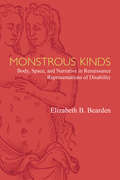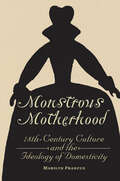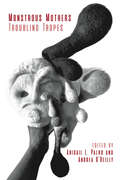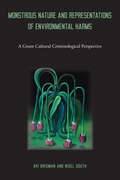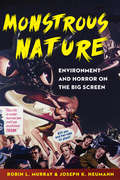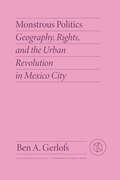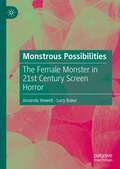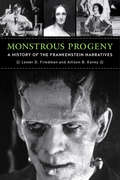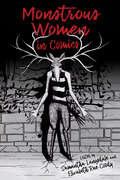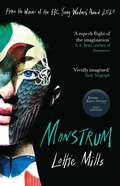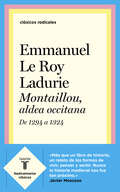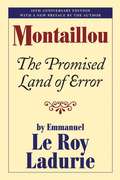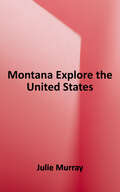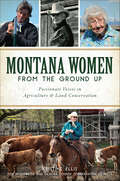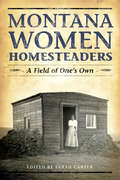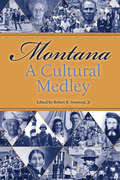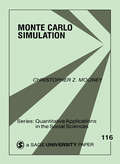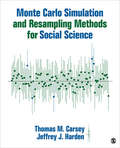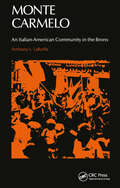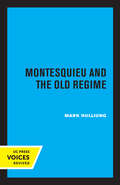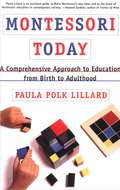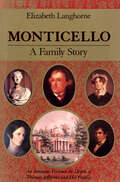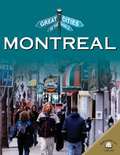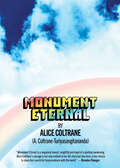- Table View
- List View
Monstrous Kinds: Body, Space, and Narrative in Renaissance Representations of Disability (Corporealities: Discourses Of Disability)
by Elizabeth BeardenMonstrous Kinds is the first book to explore textual representations of disability in the global Renaissance. Elizabeth B. Bearden contends that monstrosity, as a precursor to modern concepts of disability, has much to teach about our tendency to inscribe disability with meaning. Understanding how early modern writers approached disability not only provides more accurate genealogies of disability, but also helps nuance current aesthetic and theoretical disability formulations. The book analyzes the cultural valences of early modern disability across a broad national and chronological span, attending to the specific bodily, spatial, and aesthetic systems that contributed to early modern literary representations of disability. The cross section of texts (including conduct books and treatises, travel writing and wonder books) is comparative, putting canonical European authors such as Castiglione into dialogue with transatlantic and Anglo-Ottoman literary exchange. Bearden questions grand narratives that convey a progression of disability from supernatural marvel to medical specimen, suggesting that, instead, these categories coexist and intersect.
Monstrous Motherhood: Eighteenth-Century Culture and the Ideology of Domesticity
by Marilyn FrancusSpectral and monstrous mothers populate the cultural and literary landscape of the eighteenth century, overturning scholarly assumptions about this being an era of ideal motherhood.Although credited with the rise of domesticity, eighteenth-century British culture singularly lacked narratives of good mothers, ostensibly the most domestic of females. With startling frequency, the best mother was absent, disembodied, voiceless, or dead. British culture told tales almost exclusively of wicked, surrogate, or spectral mothers—revealing the defects of domestic ideology, the cultural fascination with standards and deviance, and the desire to police maternal behaviors. Monstrous Motherhood analyzes eighteenth-century motherhood in light of the inconsistencies among domestic ideology, narrative, and historical practice. If domesticity was so important, why is the good mother’s story absent or peripheral? What do the available maternal narratives suggest about domestic ideology and the expectations and enactment of motherhood? By focusing on literary and historical mothers in novels, plays, poems, diaries, conduct manuals, contemporary court cases, realist fiction, fairy tales, satire, and romance, Marilyn Francus reclaims silenced maternal voices and perspectives. She exposes the mechanisms of maternal marginalization and spectralization in eighteenth-century culture and revises the domesticity thesis.Monstrous Motherhood will compel scholars in eighteenth-century studies, women’s studies, family history, and cultural studies to reevaluate a foundational assumption that has driven much of the discourse in their fields.
Monstrous Mothers: Troubling Tropes
by Abigail L. Palko;Andrea O’ReillyMotherhood is one of those roles that assumes an almost-outsized cultural importance in the significance we force it to bear. It becomes both the source of and the repository for all kinds of cultural fears. Its ubiquity perhaps makes it this perfect foil. After all, while not everyone will become a mother, everyone has a mother. When we force motherhood to bear the terrors of what it means to be human, we inflict trauma upon those who mother. A long tradition of bad mothers thus shapes contemporary mothering practices (and the way we view them), including the murderous Medea of Greek mythology, the power-hungry Queen Gertrude of Hamlet, and the emasculating mother of Freud's theories. Certainly, there are mother who cause harm, inflict abuse, act monstrously. Mothers are human. But mothers are also a favourite and easy scapegoat. The contributors to this collection explore a multitude of interdisciplinary representations of mothers that, through their very depictions of bad mothering, challenge the tropes of monstrous mothering that we lean on, revealing in the process why we turn to them. Chapters in Monstrous Mothers: Troubling Tropes explore literary, cinematic, and real-life monstrous mothers, seeking to uncover social sources and results of these monstrosities.
Monstrous Nature and Representations of Environmental Harms: A Green Cultural Criminological Perspective
by Avi Brisman Nigel SouthHow does culture influence human relationships with the environment? In Monstrous Nature and Representations of Environmental Harms, green cultural criminologists Avi Brisman and Nigel South examine stories of monsters and disasters to address how the ways we depict and think about harms to the environment dissuade us from taking care of our planet and each other. The authors use examples from popular culture, including Disney and Marvel Cinematic Universe films, to consider ideas about how the environment responds to people who cause it harm. Brisman and South identify and discuss three dominant and interrelated depictions of the relationship between humans and the environment: first, nature as monstrous or fear inducing; second, nature and the Earth (or parts of it) as abject; and third, the entanglement of nature and the apocalypse, wherein nature is contributing to the end of the world, with an end point sometimes conceptualized as one without humans. Monstrous Nature and Representations of Environmental Harms argues that such representations have material consequences. The authors make the case for challenging them so that we neither perpetuate them nor retreat into cynicism and defeatism about the future of our planet.
Monstrous Nature: Environment and Horror on the Big Screen
by Robin L. Murray Joseph K. HeumannGodzilla, a traditional natural monster and representation of cinema’s subgenre of natural attack, also provides a cautionary symbol of the dangerous consequences of mistreating the natural world—monstrous nature on the attack. Horror films such as Godzilla invite an exploration of the complexities of a monstrous nature that humanity both creates and embodies. Robin L. Murray and Joseph K. Heumann demonstrate how the horror film and its offshoots can often be understood in relation to a monstrous nature that has evolved either deliberately or by accident and that generates fear in humanity as both character and audience. This connection between fear and the natural world opens up possibilities for ecocritical readings often missing from research on monstrous nature, the environment, and the horror film. Organized in relation to four recurring environmental themes in films that construct nature as a monster—anthropomorphism, human ecology, evolution, and gendered landscapes—the authors apply ecocritical perspectives to reveal the multiple ways nature is constructed as monstrous or in which the natural world itself constructs monsters. This interdisciplinary approach to film studies fuses cultural, theological, and scientific critiques to explore when and why nature becomes monstrous.
Monstrous Politics: Geography, Rights, and the Urban Revolution in Mexico City (Critical Mexican Studies)
by Ben GerlofsThe birth of the world&’s great megacities is the surest and starkest harbinger of the &“urban age&” inaugurated in the twentieth century. As the world&’s urban population achieves majority for the first time in recorded history, theories proliferate on the nature of urban politics, including the shape and quality of urban democracy, the role of urban social and political movements, and the prospects for progressive and emancipatory change from the corridors of powerful states to the routinized rhythms of everyday life. At stake are both the ways in which the rapidly changing urban world is understood and the urban futures being negotiated by the governments and populations struggling to contend with these changes and forge a place in contemporary cities.Transdisciplinary by design, Monstrous Politics first moves historically through Mexico City&’s turbulent twentieth century, driven centrally by the contentious imbrication of the Institutional Revolutionary Party (PRI) and its capital city. Participant observation, expert interviews, and archival materials demonstrate the shifting strategies and alliances of recent decades, provide the reader with a sense of the texture of contemporary political life in the city during a time of unprecedented change, and locate these dynamics within the history and geography of twentieth-century urbanization and political revolution. Substantive ethnographic chapters trace the emergence and decline of the political language of &“the right to the city,&” the establishment and contestation of a &“postpolitical&” governance regime, and the culmination of a century of urban politics in the processes of &“political reform&” by which Mexico City finally wrested back significant political autonomy and local democracy from the federal state.A four-fold transection of the revolutionary structure of feeling that pervades the city in this historic moment illustrates the complex and contradictory sentiments, appraisals, and motivations through which contemporary politics are understood and enacted. Drawing on theories of social revolution that embrace complexity, and espousing a methodology that foregrounds the everyday nature of politics, Monstrous Politics develops an understanding of revolutionary urban politics at once contextually nuanced and conceptually expansive, and thus better able to address the realities of politics in the &“urban age&” even beyond Mexico City.
Monstrous Possibilities: The Female Monster in 21st Century Screen Horror
by Lucy Baker Amanda HowellThis book focuses on how the abject spectacle of the ‘monstrous feminine’ has been reimagined by recent and contemporary screen horrors focused on the desires and subjectivities of female monsters who, as anti-heroic protagonists of revisionist and reflexive texts, exemplify gendered possibility in altered cultures of 21st century screen production and reception. As Barbara Creed notes in a recent interview, the patriarchal stereotype of horror that she named ‘the monstrous-feminine’ has, decades later, ‘embarked on a life of her own’. Focused on this altered and renewed form of female monstrosity, this study engages with an international array of recent and contemporary screen entertainments, from arthouse and indie horror films by emergent female auteurs, to the franchised products of multimedia conglomerates, to 'quality' television horror, to the social media-based creations of horror fans working as ‘pro-sumers’. In this way, the monograph in its organisation and scope maps the converged and rapidly changing environment of 21st century screen cultures in order to situate the monstrous female anti-hero as one of its distinctive products.
Monstrous Progeny: A History of the Frankenstein Narratives
by Lester D. Friedman Allison B. KaveyMary Shelley's 1818 novel Frankenstein is its own type of monster mythos that will not die, a corpus whose parts keep getting harvested to animate new artistic creations. What makes this tale so adaptable and so resilient that, nearly 200 years later, it remains vitally relevant in a culture radically different from the one that spawned its birth? Monstrous Progeny takes readers on a fascinating exploration of the Frankenstein family tree, tracing the literary and intellectual roots of Shelley's novel from the sixteenth century and analyzing the evolution of the book's figures and themes into modern productions that range from children's cartoons to pornography. Along the way, media scholar Lester D. Friedman and historian Allison B. Kavey examine the adaptation and evolution of Victor Frankenstein and his monster across different genres and in different eras. In doing so, they demonstrate how Shelley's tale and its characters continue to provide crucial reference points for current debates about bioethics, artificial intelligence, cyborg lifeforms, and the limits of scientific progress. Blending an extensive historical overview with a detailed analysis of key texts, the authors reveal how the Frankenstein legacy arose from a series of fluid intellectual contexts and continues to pulsate through an extraordinary body of media products. Both thought-provoking and entertaining, Monstrous Progeny offers a lively look at an undying and significant cultural phenomenon.
Monstrous Women in Comics (Horror and Monstrosity Studies Series)
by Samantha Langsdale and Elizabeth Rae CoodyContributions by Novia Shih-Shan Chen, Elizabeth Rae Coody, Keri Crist-Wagner, Sara Durazo-DeMoss, Charlotte Johanne Fabricius, Ayanni C. Hanna, Christina M. Knopf, Tomoko Kuribayashi, Samantha Langsdale, Jeannie Ludlow, Marcela Murillo, Sho Ogawa, Pauline J. Reynolds, Stefanie Snider, J. Richard Stevens, Justin Wigard, Daniel F. Yezbick, and Jing Zhang Monsters seem to be everywhere these days, in popular shows on television, in award-winning novels, and again and again in Hollywood blockbusters. They are figures that lurk in the margins and so, by contrast, help to illuminate the center—the embodiment of abnormality that summons the definition of normalcy by virtue of everything they are not. Samantha Langsdale and Elizabeth Rae Coody’s edited volume explores the coding of woman as monstrous and how the monster as dangerously evocative of women/femininity/the female is exacerbated by the intersection of gender with sexuality, race, nationality, and disability. To analyze monstrous women is not only to examine comics, but also to witness how those constructions correspond to women’s real material experiences. Each section takes a critical look at the cultural context surrounding varied monstrous voices: embodiment, maternity, childhood, power, and performance. Featured are essays on such comics as Faith, Monstress, Bitch Planet, and Batgirl and such characters as Harley Quinn and Wonder Woman. This volume probes into the patriarchal contexts wherein men are assumed to be representative of the normative, universal subject, such that women frequently become monsters.
Monstrous Work and Radical Satisfaction: Black Women Writing under Segregation
by Eve DunbarRadical Black feminist refusal through the works of mid-twentieth-century African American women writers Monstrous Work and Radical Satisfaction offers new and insightful readings of African American women&’s writings in the 1930s–1950s, illustrating how these writers centered Black women&’s satisfaction as radical resistance to the false and incomplete promise of liberal racial integration. Eve Dunbar examines the writings of Ann Petry, Dorothy West, Alice Childress, and Gwendolyn Brooks to show how these women explored self-fulfillment over normative and sanctioned models of national belonging. Paying close attention to literary moments of disruption, miscommunication, or confusion rather than ease, assimilation, or mutual understanding around race and gender, Dunbar tracks these writers&’ dissatisfaction with American race relations. She shows how Petry, West, Childress, and Brooks redeploy the idea of monstrous work to offer potential modalities for registering Black women&’s capacity to locate satisfaction within the domestic and interpersonal. While racial integration may satisfy the national idea of equality and inclusion, it has not met the long-term needs of Black people&’s quest for equity. Dunbar responds, demonstrating how these mid-century women offer new blueprints for Black life by creating narrative models for radical satisfaction: Black women&’s completeness, joy, and happiness outside the bounds of normative racial inclusion.
Monstrum: Longlisted for the 2025 Dylan Thomas Prize
by Lottie Mills* From the winner of the BBC Young Writers' Award 2020 * What does it mean to be different in a world that values perfection, at any cost? 'Lottie's writing is a superb flight of the imagination' A.S. Byatt, author of Possession 'Haunting, luridly beautiful, and at times shockingly, deliciously gruesome&’ Jenn Ashworth, author of Ghosted A 'Best Book for May 2024' according to Cosmopolitan From Lottie Mills, the winner of the BBC Young Writers' Award in 2020, comes this beautifully crafted collection of stories. A father and daughter build a life for themselves on an isolated beach. But the outside world is pressing in. It's only a matter of time before their secret refuge is discovered. A young disabled woman opts to receive a perfect, pain-free body. Soon, however, she finds herself haunted by the one she cast off. A travelling circus master discovers the ideal addition to his cabinet of curiosities: 'damaged', 'grotesque', gifted. He plans to make her the star of his show; she plans to take her revenge. Monstrum captures the experience of characters excluded by a society that cannot accept their difference. Eerie, fantastical and hugely ambitious, this collection announces the arrival of an outstanding new literary voice. 'Lottie's stories reminded me of what matters' Claire Oshetsky 'Magical and haunting' Jan Carson
Montaillou: The Promised Land Of Error (Peregrine Bks. #No. 9)
by Emmanuel Le Roy LadurieUn libro que recrea como ninguno la verdadera mentalidad de la Europa medieval. Montaillou, aldea del sudoeste francés, fue hogar, durante el siglo XIV, de un buen número de inconformistas, herejes cátaros. Jacques Fournier, obispo del lugar (y futuro Papa de Aviñón), los persiguió e interrogó implacablemente hasta desenterrar la intimidad cotidiana, los dramas personales y, en definitiva, todos los secretos de la zona. Los extraordinarios escritos resultantes fueron interpretados, seiscientos cincuenta años después, por el historiador Emmanuel Le Roy Ladurie a la luz de la antropología, la sociología y la psicología modernas. En este maravilloso libro supo dar vida a este pueblecito y a sus habitantes. Emmanuel Le Roy Ladurie (Les Moutiers-en-Cinglais, 1929) es uno de los más prestigiosos historiadores franceses, miembro destacado de la Escuela de los Annales. Este profesor, que ocupó la cátedra de historia de la civilización moderna en el Collège de France durante más de veinticinco años, ha sido un pionero en terrenos como la historia desde abajo y la microhistoria. -------------- radical: adj. Perteneciente o relativo a la raíz. Clásicos Radicales nace con la misión de recuperar algunos de los libros más emblemáticos del sello que en su día formularon una idea nueva u ofrecieron una mirada original y pertinente sobre las grandes cuestiones universales. Ausentes de las librerías durante demasiado tiempo pero recordados y buscados por los lectores más despiertos, estos textos esenciales de disciplinas como la filosofía, la ética, la historia, la sociología, la economía, la antropología, la psicología y la política mantienen su plena vigencia y vuelven hoy con fuerza para iluminar nuestro presente. ------------- La crítica ha dicho...«Más que un libro de historia, un relato de las formas de vivir, pensar y sentir. Nunca la historia medieval nos fue tan próxima.»Javier Moscoso
Montaillou: The Promised Land of Error
by Emmanuel Le Roy LadurieWith a new introduction by author Le Roy Ladurie, this special edition offers a fascinating history of a fourteenth-century village, Montaillou, in the mountainous region of southern France, almost destroyed by internal feuds and religious heterodoxy. Ladurie's portrait is based on a detailed register of Jacques Fournier, Bishop of Pamiers and future Pope Benedict XII, who conducted rigorous inquisition into heresy within his diocese. Fournier was a consummate inquisitor, an acute psychologist who was able to elicit from the accused the innermost secrets of their thoughts and actions. He was pitiless in the pursuit of error, and meticulous in recording that pursuit. LeRoy Ladurie analyzes the behavior, demography, social mentality, and cosmology of the community of peasants and shepherds, and vividly evokes the daily life of the village and mountain pastures. His portrait of Montaillou is dominated by the personal histories of two men: the cure Pierre Clergue, a brutal and powerful man who placed his enemies in the hands of the inquisitor; and the shepherd Pierre Maury, a friend of the Albigensian perfecti and a fatalist who returned from Spain to disappear in the inquisitor's prison in his own country. Montaillou, which has received even more praise than LeRoy Ladurie's earlier work, provides a portrait of a fascinating place with a dark, intriguing history.
Montana (Explore the United States)
by Julie MurrayInvite your students to explore the state of Montana in this comprehensive title! <p><p> Informative, easy-to-read text draws in reluctant readers, while vibrant, oversized photos showcase the beauty and diversity of this state. Readers journey through Montana as they learn about its history, cities, land features, animals, industries, famous people, and more! <p><p> A "Tour Book" spread highlights kid-friendly things to do in Montana. Other features include a table of contents, fact boxes, a timeline, regional and state maps, a facts page with vital information, a glossary with phonetic spellings, and an index. Up-to-date population statistics are taken from the 2010 US census. In this title, students will find valuable information for first reports! <p><p> Aligned to Common Core Standards and correlated to state standards.
Montana Women From The Ground Up: Passionate Voices in Agriculture & Land Conservation (American Heritage)
by Kristine E. EllisGrowing up on the family ranch, Linda Finley fought hard to gain the acceptance and respect as a ranch hand that her brothers took for granted. Arlene Pile barely remembers learning to ride a horse and run machinery--she was so young. She learned to drive on an 8N Ford tractor with a buck rake. Lee Jacobsen became the first woman in the state licensed to artificially inseminate cattle. Meet these and other Montana women passionate about caring for their land and determined to make the lifestyle their own. Many never doubted for a moment that they would spend their lives in agriculture, while others speak of their surprise and delight to find themselves living on the land. All agree that they wouldn't be happy doing anything else.
Montana Women Homesteaders: A Field of One's Own
by Sarah CarterIn Montana Women Homesteaders: A Field of One's Own, Sarah Carter introduces the voices and images of women who filed on 160- or 320-acre homestead plots in Montana. Single, widowed, divorced, or deserted, women varied in ages, educational levels, and ethnic backgrounds, but all "proved up" on their homesteads. In published accounts, scrapbooks, personal reminiscences, and photographs, the women recorded their remarkable journeys.
Montana: a Cultural Medley
by Robert R. Jr. SwartoutThe whole is greater than the sum of the parts when Montana historian Robert Swartout gathers the fascinating stories of the state's surprisingly diverse ethnic groups into this thought-provoking collection of essays. Fourteen chapters showcase an African American nightclub in Great Falls, a Japanese American war hero, the founding of a Metís community, Jewish merchants, and Dutch settlement in the Gallatin Valley, as well as stories of Irish, Scots, Chinese, Finns, Mexican Americans, European war brides, and more.
Monte Carlo Simulation (Quantitative Applications in the Social Sciences)
by Christopher Z. MooneyMonte Carlo Simulation is a method of evaluating substantive hypotheses and statistical estimators by developing a computer algorithm to simulate a population, drawing multiple samples from this pseudo-population, and evaluating estimates obtained from these samples. Christopher Z. Mooney explains the logic behind Monte Carlo Simulation and demonstrates its uses for social and behavioral research in conducting inference using statistics with only weak mathematical theory, testing null hypotheses under a variety of plausible conditions, assessing the robustness of parametric inference to violations of its assumptions, assessing the quality of inferential methods, and comparing the properties of two or more estimators. In addition, Mooney carefully demonstrates how to prepare computer algorithms using GAUSS code and illustrates these principles using several research examples. is a method of evaluating substantive hypotheses and statistical estimators by developing a computer algorithm to simulate a population, drawing multiple samples from this pseudo-population, and evaluating estimates obtained from these samples. Christopher Z. Mooney explains the logic behind and demonstrates its uses for social and behavioral research in conducting inference using statistics with only weak mathematical theory, testing null hypotheses under a variety of plausible conditions, assessing the robustness of parametric inference to violations of its assumptions, assessing the quality of inferential methods, and comparing the properties of two or more estimators. In addition, Mooney carefully demonstrates how to prepare computer algorithms using GAUSS code and illustrates these principles using several research examples. Monte Carlo Simulation will enable researchers to effectively execute Monte Carlo Simulation and to interpret the estimated sampling distribution generated from its use. will enable researchers to effectively execute Monte Carlo Simulation and to interpret the estimated sampling distribution generated from its use.
Monte Carlo Simulation and Resampling Methods for Social Science
by Jeffrey J. Harden Thomas M. CarseyTaking the topics of a quantitative methodology course and illustrating them through Monte Carlo simulation, this book examines abstract principles, such as bias, efficiency, and measures of uncertainty in an intuitive, visual way. Instead of thinking in the abstract about what would happen to a particular estimator "in repeated samples," the book uses simulation to actually create those repeated samples and summarize the results. The book includes basic examples appropriate for readers learning the material for the first time, as well as more advanced examples that a researcher might use to evaluate an estimator he or she was using in an actual research project. The book also covers a wide range of topics related to Monte Carlo simulation, such as resampling methods, simulations of substantive theory, simulation of quantities of interest (QI) from model results, and cross-validation. Complete R code from all examples is provided so readers can replicate every analysis presented using R.
Monte Carmelo: An Italian-American Community in the Bronx (The Library of Anthropology)
by Anthony L. LaRuffaFirst Published in 1988. There are somewhat fewer than 12,000,000 Italian-Americans of both single ancestry and multiple ancestry living in the United States. They comprise 5.3 percent of the total population. This is a study of one particular segment of the larger metropolitan region. Located in the central part of the Bronx, Monte Carmelo’s beginning as an Italian-American community dates back to the last decade of the nineteenth century when immigrants from southern Italy and Italian-Americans from neighborhoods in New York City began moving in.
Montesquieu and the Old Regime
by Mark HulliungThis title is part of UC Press's Voices Revived program, which commemorates University of California Press’s mission to seek out and cultivate the brightest minds and give them voice, reach, and impact. Drawing on a backlist dating to 1893, Voices Revived makes high-quality, peer-reviewed scholarship accessible once again using print-on-demand technology. This title was originally published in 1976.
Montessori Today: A Comprehensive Approach to Education from Birth to Adulthood
by Paula Polk LillardPaula Lillard, director of a Montessori school ranging in age from 18 months to fifteen years, provides a clear and cogent introduction to the Montessori program for the elementary and later years. In detailed accounts, Lillard shows how children acquire the skills to answer their own questions, learn to manage freedom with responsibility, and maintain a high level of intellectual stimulation by using the Montessori method. This is an essential handbook for parents and teachers who have chosen the Montessori alternative for the older child.From the Trade Paperback edition.
Monticello: A Family Story
by Elizabeth LanghorneThomas Jefferson, the public man, is a familiar and oft-chronicled figure. But the private Thomas Jefferson has been little studied. Now Elizabeth Langhorne, drawing upon public records and hitherto-unpublished documents, has produced an intimate and fascinating account of our third president and numerous members of his family, including some of his slaves, as they lived their private and sometimes tumultuous lives at Jefferson's beloved Monticello. Includes illustrations.
Montreal (Great Cities of the World Ser.)
by Percy Rowe Patience CosterGreat Cities of the World takes you on a trip around the globe to discover the world's largest, most important and prominent cities. Each title explores the history, landmarks, culture, and economy of a city and introduces readers to the people who live there. In addition to informative text illustrated with up-to-date, full-color photography, Great Cities of the World titles feature time lines, statistics, excerpts from primary sources, and sources of further information.
Monument Eternal
by Alice ColtraneThe long-awaited reissue of Alice Coltrane’s original spiritual teachings and reflections, which provide powerful insight into her transcendent music, cherished by millions across the globe ALICE COLTRANE (1937–2007) was a composer, master of various musical instruments, improviser, spiritual leader, and wife of John Coltrane. Throughout her adult life, she worked within and combined a broad range of musical genres, including gospel, R&B, bebop, free jazz, Indian devotional song, and Western art music. She recorded more than twenty full-length albums for Impulse and Warner Bros. Her music speaks to her experiences as a child playing for church congregations in Detroit; the transcendent and mind-bending avant-garde improvisations she performed with her husband John Coltrane; and her religious pilgrimages to India. When Monument Eternal was originally published in 1977, Alice Coltrane was living in Southern California and had recently become a swami, building and nurturing an alternative spiritual community. In these pages, she says that the book is “based upon the soul’s realizations in Absolute Consciousness and its spiritual relationships with the Supreme One.” Monument Eternal offers deep insight into Coltrane’s tremendous musical output, and shines a light on her transformation from Alice McLeod, Detroit church organist and bebopper, to sage thought leader Swami Turiyasangitananda. It also reflects the extraordinary fluidity of American religious customs in the mid and late twentieth century. Akashic’s long-awaited reissue of Monument Eternal includes a new foreword by Ashley Kahn.
